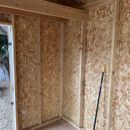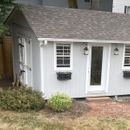insulating shed made from LP SmartSide and 2×4 framing
Hello,
I am looking for advice on “layers” and materials for insulating my shed as I electrify and convert it to a workspace. This is a small 16′ x 12′ structure in the near Seattle, Washington in the Pacific Northwest, building zone 4.
The walls use a siding+sheathing in one product, LP SmartSide, and it was not wrapped wit Tyvek between sheathing and framing during construction.
I’ve been told that putting fiberglass insulation up against the raw siding could wick moisture in and not to use that material. Someone suggested cutting 2″ R10 XPS foam insulation and either friction fitting with GapoTape (is there a similar product in the U.S.A.?) into the stud bays, or purposely leaving a 1/2″ gap on all sides and filling that with spray foam would be the way to go.
I’m wondering: 1) would it be advantageous to line it from the back with Tyvek? I’d have to wrap it around each stud, which would place both studs and the siding outside the barrier. Or will the XPS be enough of a moisture barrier? And 2) should I place the foam directly against the siding (or Tyvek if used) leaving an air gap between the foam and sheetrock, or have the foam flush with the sheetrock, leaving an airgap between the foam and siding? I’m thinking there would be an 1 1/2″ airgap between foam and either siding or sheetrock depending, unless I fill most of that with another layer of foam like 1″ R5.
Although it’s “just a shed” the intention is to have a mini-split with heating and cooling and to create a nice work environment in both winter and summer.
The photo shows the construction. The overhead “shelf” has been removed.
Thank you
GBA Detail Library
A collection of one thousand construction details organized by climate and house part












Replies
If you're certain there's no leaks, I think the cost/benefit analysis would weigh heavily in favor of just putting in R13 batt fiberglass insulation, and calling it done. The air-tightness of the shed is probably zero, so it's not as if the air barrier property of the tyvek will help. The smart-side is already much less vapor permeable than tyvek would be too. The kraft facing on the batts is permeable enough to allow the batts to dry if there would be vapor ingress.
Wrapping the stud bays in tyvek would be quite a bit of work, and I'm not sure it would buy you much for the cost/effort/time involved.